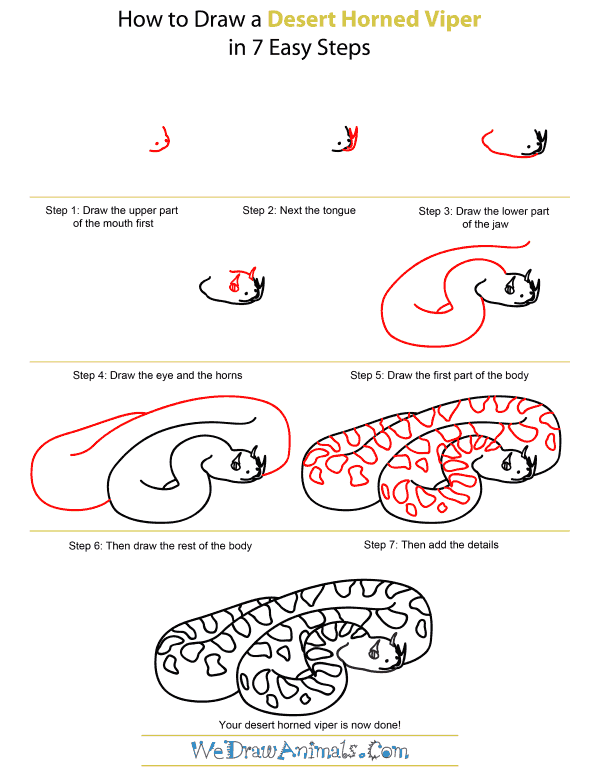In this quick tutorial you'll learn how to draw a Desert Horned Viper in 7 easy steps - great for kids and novice artists.
The images above represent how your finished drawing is going to look and the steps involved.
Below are the individual steps - you can click on each one for a High Resolution printable PDF version.
At the bottom you can read some interesting facts about the Desert Horned Viper.
Make sure you also check out any of the hundreds of drawing tutorials grouped by category.
How to Draw a Desert Horned Viper - Step-by-Step Tutorial
Step 1: Start drawing your Horned Viper by making the front curve of its face. It can be a little bumpy, to imply the bone structure beneath the skin. Add two dots near the front to make the nostrils.
Step 2: Now draw the tongue. It should be coming out just between the nostrils you drew, and be made of two lines that split apart. Connect the two tips with a V shape to make your snake's forked tongue.
Step 3: Next draw the rest of the head, by drawing a curve that starts right where the tongue is coming out, and continues to the curve of the snake's jaw on its left side. Again make it a bit bumpy in places to imply bones.
Step 4: Now let's add the eyes, and the distinctive 'horns' that these vipers are known for. An oval for the eye is fine, but put a vertical oval inside of it to make the snake's pupil. Then add a triangle shape on top to make the horn over that eye. On the right side, make another small, pointed triangle shape to make the other horn. Then add a curve behind the right horn to draw the rest of the head.
Step 5: Drawing the body looks like a lot of work, but let's just break it down into a few steps. First draw three lines. The first line will be the biggest, starting at the jaw and curving down and around, before curving behind the viper itself. The next line will be smaller, starting on the top of the viper's head, going up and then down, to the left. Make one more line to imply the obscured lower portion of the snake's body.
Step 6: The rest of the body can be drawn with two lines! The first starts right at the snake's tongue, and curves up, then back around, ending not far beyond the body you've already drawn. The second starts at the left-most part of the body you've drawn, and curves up into a nice round shape, before slanting up and to the right.
Step 7: Now draw all the spots that are found on Horned Vipers. Go ahead and color them in too! The colors of Vipers are yellow, brown, an gray, but you can color this snake however you like!
Interesting Facts about Desert Horned Vipers
Desert horned vipers are an endangered species of snake that live in northern Africa, Arabia, Israel, and the Sinai Peninsula. Desert horned vipers got their names because they live in the desert and have devil-like horns.
Did You Know?
- Desert horned vipers are carnivores that eat rodents, lizards, and other small animals.
- The average length of a desert horned viper is a little less than two feet.
- Desert horned vipers blend into the ground. The colors of their body are yellow, brown, and gray.
- Desert horned vipers are nocturnal, meaning that they are most active at night time.
- Desert horned vipers move their bodies by “sidewinding,” which means that they slide sideways.
- The average lifespan of desert horned vipers is 10 to 15 years.
- Female desert horned vipers lay 12 to 24 eggs at a time. It takes about 50 to 80 days for the eggs to hatch.
Desert horned vipers had a role in Egyptian history. Ancient Egyptians mummified desert horned vipers, and the mummies were discovered near the Nile River centuries later. According to history books, the famous Cleopatra committed suicide by making a snake bite her. That snake was believed to be a desert horned viper.








